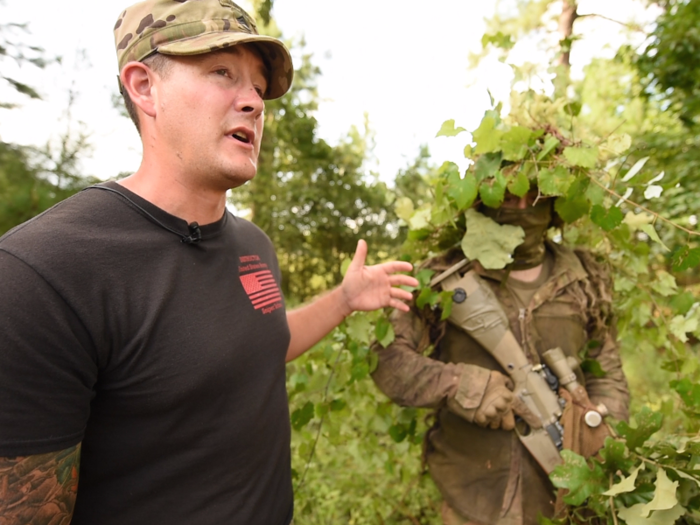- Home
- Military & Defense
- Take a look at the grimy and grueling training the Army uses to turn soldiers into snipers
Take a look at the grimy and grueling training the Army uses to turn soldiers into snipers
Over 300 candidates start the seven-week Sniper School course at Fort Benning each year. In early August, 46 soldiers were on hand for the first day. Each had already met demanding criteria, including navigation and marksmanship evaluations, physical-fitness tests, and psychological examinations.

"Snipers are often deployed in small two-man teams, which requires a great deal of mental fortitude to remain focused on the task at hand," said Moran, the Sniper School instructor. "If individuals have difficulty being isolated, there is a potential for mission failure."

Source: US Army
After a battery of physical-fitness tests on the first day, candidates are taught to make a ghillie suit — a camouflage suit that uses foliage to break up the outline of the soldier's body.

Source: US Army
The first test of their new concealment comes hours later, crawling hundreds of feet through tall grass and a ditch filled with water, mud, rocks, and vegetation.

Source: US Army
Part of the exercised requires students to carry and drag one another — testing their ability to help their comrades if one is wounded or incapacitated in the field. "The object of this training is to teach students that being a sniper can be a difficult and dirty job," Moran said. "These are the conditions that snipers will often find themselves in."

Source: US Army
The second week of training sends them into the field to stalk a target, putting students' patience and camouflage to the test. The Georgia heat and a variety of critters combine with instructors using high-powered optics to suss out prospective snipers. Stalking requires close attention to detail and "a high tolerance for discomfort," Moran said. "Most of the students who are dropped from the sniper course have failed because of their lack of discipline."

Source: US Army
Also during the second week, sniper candidates are taught to do reconnaissance, which is part of their secondary mission to collect and report battlefield information. Snipers who can operate with little support and carry out those missions, Moran said, can aid commanders at every level. "Snipers are force multipliers," he told Army News Service.

Source: US Army
The third week mixes classroom work with firing on a range. Students are taught how to communicate with spotters, and they fire 80 to 120 rounds a day at targets ranging from 300 meters to 800 meters away. Starting in week three, students are paired up and alternate turns as sniper and as spotter. The duos are trained to work in tandem to track targets and defend themselves.

After the soldier's third week, the trials turn from physical to mental. The fourth week adds night-fire and limited-visibility firing scenarios. Record-fire tests see snipers paired with spotters and given five targets and a seven-minute time limit. The pressure becomes too much for some, and three students were sent home.

Source: US Army
Week five challenges sniper candidates to hit targets at unknown distances, as well as moving targets. "Students must learn how to properly lead their target so the round will impact a given position when the target will be there," Moran said. Two more students were sent home.

Source: US Army
The demands do not slack in week six. They are taught to use new weapons, like the M9 pistol or the M107 .50-caliber sniper rifle, and to fire from unstable platforms or other positions. The seventh week, known as the "employment phase," challenges students to plan and carry out a mission after receiving an operational order.

Source: US Army
The course culminates in week seven with time-limited road march to a range for a "final shot." Given two bullets and one target, students must calculate range and engage, with their scores determining honor graduate and "top gun" status for graduation. At graduation on September 22, just four of the 46 students remained. "The training in sniper school is hands down the best I've received in the Army," said Sgt. Stephen Ray, a member of the 1st Armored Brigade who graduated No. 1 in the class — Top Gun.

Source: US Army
Popular Right Now
Popular Keywords
Advertisement